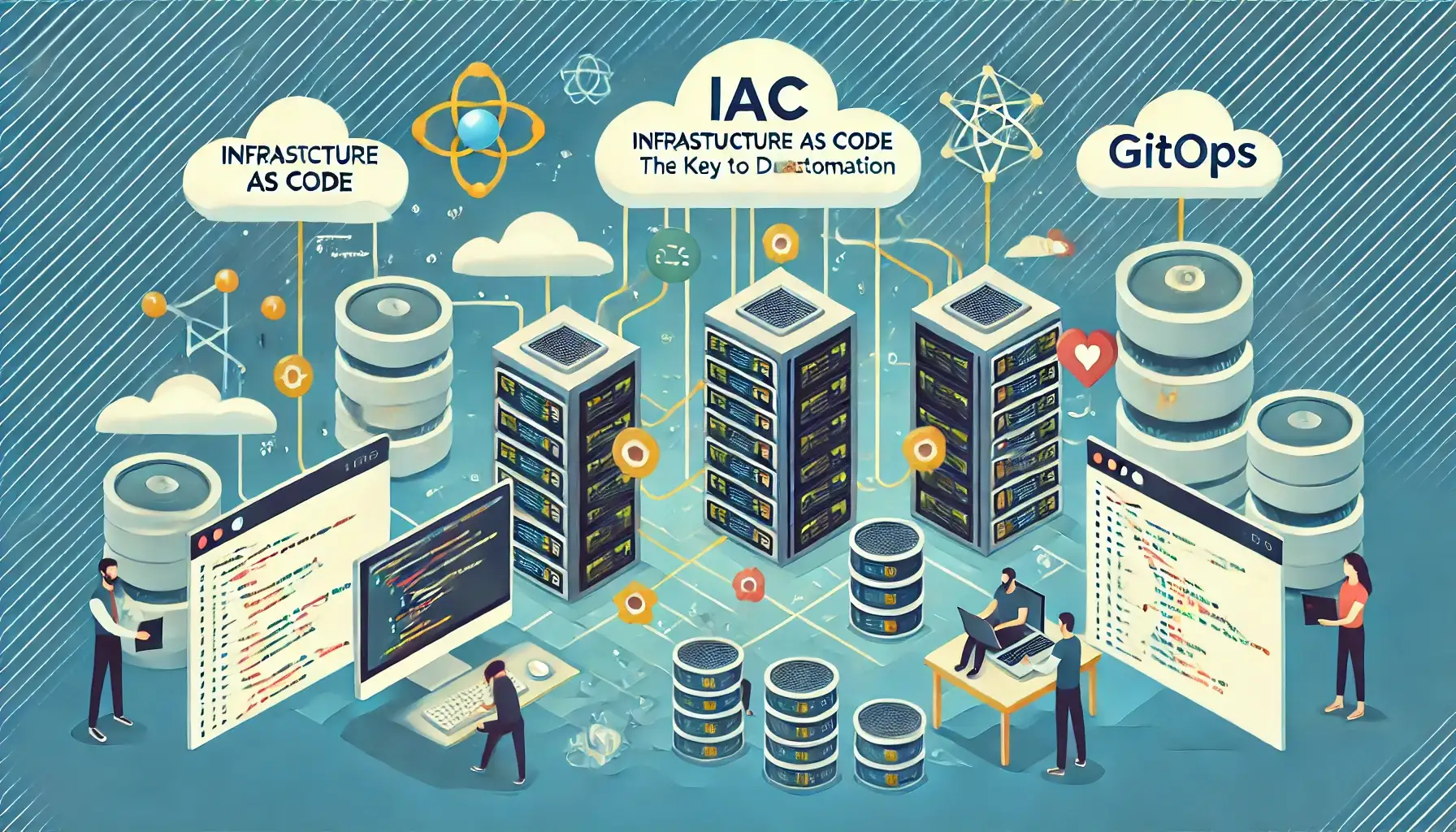Infrastructure as Code (IaC) and GitOps: The Key to DevOps Automation
Published by: Vinu VijayanMar 25, 2025Blog
In today's fast-paced digital economy, organizations must deliver software faster, more reliably, and at scale. Traditional infrastructure provisioning and deployment methods are no longer sufficient. Enter Infrastructure as Code (IaC) and GitOps--two pivotal practices redefining how we manage infrastructure and applications in the age of DevOps automation.
At Evalogical, we have helped enterprises across industries streamline and scale their software delivery pipelines by embedding these automation-first practices. In this blog, we explore how IaC and GitOps work together, their strategic advantages, practical use cases, and a roadmap for successful adoption.
What Is Infrastructure as Code (IaC)?
Infrastructure as Code (IaC) is the process of managing and provisioning computing infrastructure through machine-readable definition files, rather than through physical hardware configuration or interactive configuration tools.
Instead of clicking through cloud dashboards or manually configuring servers, you write code--commonly in YAML, JSON, or HCL--that defines your desired infrastructure state. This code can be stored, version-controlled, tested, and reused like any application source code.
What are The Core Principles of Infrastructure as Code:
- Declarative Definition: You define what infrastructure you need, not how to build it.
- Version Control: All infrastructure changes are tracked, reviewed, and rolled back using tools like Git.
- Automation-First: Infrastructure is provisioned through repeatable, scriptable automation.
- Immutability: Each deployment creates a new version of infrastructure, ensuring consistency and auditability.
What are The Benefits of Infrastructure as Code
- Speed & Agility: Provision environments within minutes.
- Consistency: Eliminate configuration drift between development, staging, and production.
- Reusability: Modularize infrastructure for different teams or services.
- Compliance: Ensure traceability and governance in regulated industries.
What are The Popular Infrastructure as Code Tools
- Terraform (HashiCorp)
- AWS CloudFormation
- Pulumi
- Ansible
- Chef / Puppet
What Is GitOps?
GitOps is an operational framework that extends DevOps by using Git as the central control mechanism for deploying and managing infrastructure and applications.
At its core, GitOps treats Git repositories as the source of truth for declarative infrastructure and application configurations. When combined with automation tools, any changes pushed to the repository are automatically validated, tested, and applied to the environment.
Key Concepts of GitOps
- Git as the Single Source of Truth
- Declarative Infrastructure
- Automated Delivery Pipelines
- Pull-Based Deployments
GitOps tools like FluxCD, ArgoCD, and Jenkins X continuously monitor Git repositories for changes and reconcile the live environment to match the desired state.
Benefits of GitOps
- Full Audit Trail: Track every change through Git history.
- Faster Rollbacks: Revert to a known state instantly.
- Developer Autonomy: Enable self-service deployments with built-in safety nets.
- Improved Security: Git-based approval workflows ensure fewer surprises in production.
Why IaC and GitOps Work Better Together
While IaC enables infrastructure automation, GitOps enhances it by adding Git-based workflows, continuous synchronization, and improved observability. Together, they form a scalable, resilient, and auditable DevOps ecosystem.
Complementary Strengths
- IaC defines the infrastructure (servers, networks, storage)
- GitOps manages its lifecycle through Git workflows and automation
This model helps teams achieve true infrastructure automation, eliminating human error, reducing mean time to recovery (MTTR), and increasing deployment frequency.
Real-World Benefits
- Faster Time-to-Market: Automated provisioning + Git-based deployments accelerate application delivery.
- Resilience & Recovery: Rollbacks become as simple as reverting a Git commit.
- Compliance by Design: Every change is tracked, reviewed, and testable.
These advantages align with our DevOps consulting services, which focus on helping enterprises design future-ready automation frameworks using IaC and GitOps.
How to Implement IaC and GitOps
Successfully implementing IaC and GitOps involves technical readiness, cultural shifts, and iterative maturity. Here's a step-by-step framework we follow at Evalogical:
1. Assess DevOps Maturity
Begin with a maturity assessment of your current delivery process, tooling, and culture. This helps identify readiness and roadmap gaps.
Explore our strategic IT consulting for maturity models and gap analysis frameworks.
2. Choose the Right Tooling
Select tools based on your architecture, cloud providers, and team capabilities:
- IaC: Terraform for multi-cloud, CloudFormation for AWS-native
- GitOps: ArgoCD or FluxCD for Kubernetes environments
3. Define Infrastructure as Code
Break down infrastructure into modular components:
- VPCs
- Subnets
- IAM roles
- Databases
- Load balancers
Structure code in version-controlled repositories with proper naming conventions, tags, and lifecycle management.
4. Set Up GitOps Pipelines
Create Git repositories for:
- Infrastructure modules
- Application manifests
- Environment configurations
Use CI tools (Jenkins, GitHub Actions) and GitOps controllers (ArgoCD) to automatically detect changes and apply them to staging/production environments.
5. Monitor, Audit, and Improve
Incorporate observability tools (Prometheus, Grafana) and set up alerts, dashboards, and security scanning. Perform regular audits and chaos testing to harden resilience.
Challenges to Navigate
While IaC and GitOps bring immense value, organizations often face these common hurdles:
Many teams are new to writing declarative infrastructure or working with GitOps tooling. Upskilling is essential.
Tip: Partner with Evalogical for customized training and enablement workshops.
Integrating CI/CD pipelines, GitOps controllers, monitoring, secrets management, and cloud APIs can become overwhelming.
Tip: Start small, automate critical infrastructure first, and iterate.
Siloed teams and misaligned priorities often slow down adoption.
Tip: Foster DevSecOps culture by aligning development, operations, and security stakeholders.
Best Practices for Success
- Write Modular IaC: Break down infrastructure into reusable modules.
- Tag Everything: Use consistent naming and tagging for traceability.
- Enforce Git Workflows: Protect main branches, use PR reviews, and enable Git hooks.
- Implement Policy-as-Code: Enforce security and compliance rules using tools like OPA and Sentinel.
- Test Infrastructure Code: Use Terratest or Checkov for automated infrastructure validation.
- Automate Secrets Management: Use tools like HashiCorp Vault or AWS Secrets Manager.
Conclusion: Embrace the Future of DevOps with Evalogical
Infrastructure as Code (IaC) and GitOps are not just trends--they are foundational to building resilient, scalable, and efficient DevOps ecosystems.
At Evalogical, we combine deep technical expertise with cross-industry experience to help organizations implement DevOps automation strategies that deliver real business outcomes. Whether you're modernizing a legacy stack or building cloud-native systems, we tailor solutions that work for your goals, culture, and architecture.



 A Proven ColdFusion Migration ....
A Proven ColdFusion Migration ....
 ColdFusion Maintenance Guide: ....
ColdFusion Maintenance Guide: ....
 Brand Refresh vs. Rebrand: You....
Brand Refresh vs. Rebrand: You....
 Brand Positioning Explained: Y....
Brand Positioning Explained: Y....
 Top Benefits of XBRL and FATCA....
Top Benefits of XBRL and FATCA....



Your Trusted Software Development Company